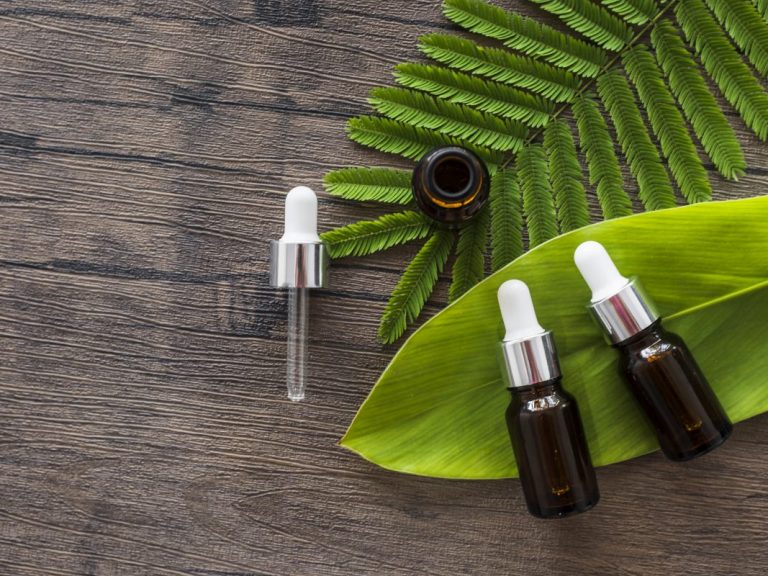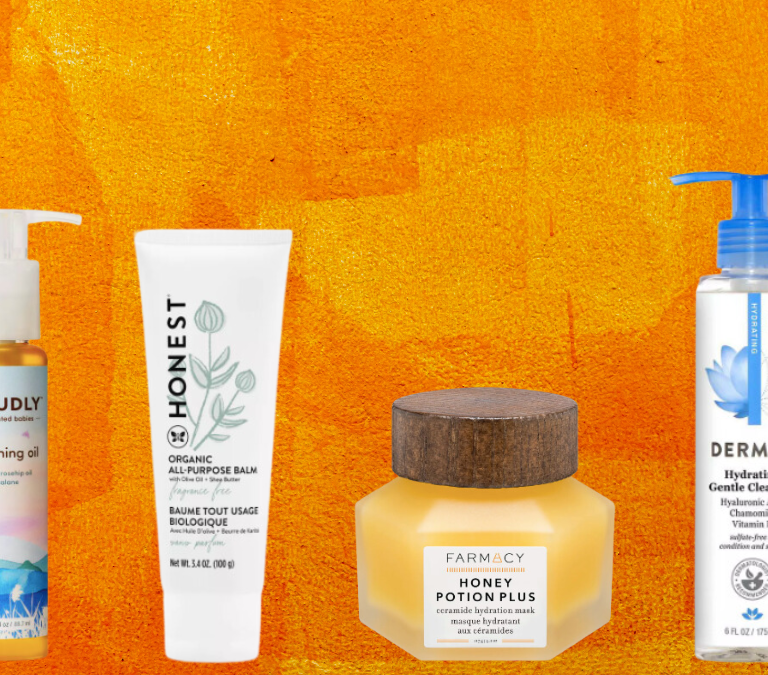When it comes to anti-aging products, it’s easy to be tricked into spending a lot of money on products that aren’t worth it. That’s because there’s so much pseudoscientific misinformation out there about anti-aging cosmetic ingredients. Also, once you buy an anti-aging product, it takes a long time to determine whether it’s really working. That’s why we’re going to focus some of our podcast episodes on specific anti-aging ingredients. Today we’re talking about ceramides.
What Are Ceramides?
“Ceramide” is one of those buzzwords that gets thrown around a lot in the beauty industry, especially in regard to anti-aging. But I’ve never seen a good explanation of what a ceramide is, what it really does, and what to look for in a product. That’s what we’re going to cover today, starting with a little chemical background…
A ceramide is a special type of oily wax that’s naturally found in our skin (and other places). In fact, the word ceramide comes from the Latin cera, which means wax. Ceramides form a kind of water-proofing barrier in the upper layers of skin. They’re not only critical for helping skin retain water but they also help repair the skin’s natural barrier and regulate cells. Ceramide production dwindles with age which can result in dry skin, wrinkles and even some types of dermatitis.
Did you know that newborn infants, especially premature ones, may be born with a waxy or cheese-like coating on their skin that prevents them from losing too much moisture? That coating is called the vernix caseosa and it is composed, primarily, of ceramides.
Chemically speaking, ceramides consist of a long-chain or sphingoid base linked to a fatty acid. By the way, “sphingoid bases” were first discovered in brain fluid and they’re named after the Sphinx because the chemist who found them thought they had an “enigmatic structure.” Anyway, sphingoids make up about half of a ceramide. Therefore, ceramides are not a single thing; different types of ceramides can be made depending on which specific base and which fatty acid are combined. There are at least 9 different types of ceramides found naturally. To make things even more confusing, there are not only ceramides but also phytoceramides, psuedoceramides, and synthetic ceramides. So let’s define these before we go any further.
Ceramide: A waxy lipid that occurs naturally in skin. It’s made by combining a fatty acid with a sphingoid base.
Phytoceramide: A ceramide made with a phytosphingosine (a special type of sphingosine found in yeast, plants and some mammalian tissues. Don’t get tricked by this because “phyto” is a buzz word for “made from plants,” so this sounds like a cool, green ingredient. In reality, it’s sourced from yeast.)
Pseudo-ceramide: A lipid that has similar properties to a ceramide but which has a different structure. For example, Ceramide E is a pseudo-ceramide. Another example is Arachamide MEA. Pseudo-ceramides may be naturally occurring but typically are made synthetically.
Synthetic ceramide: A lab-created version of a ceramide found in nature.
For the most part, ceramides used in skin care are synthetic (whether they are true ceramides or pseudoceramides). Ceramides can be sourced naturally but they are present at only low concentrations in plants and animals, so naturally derived ceramides are expensive. And besides, based on what we’ve seen, it doesn’t matter if the ceramide is natural or synthetic, as long as it has the right structure.
Understanding Ceramide Nomenclature
Understanding which ceramides are used in cosmetics is confusing because there are three different ways they can be named:
1. The original INCI name, which simply refers to each ceramide by a number.
2. The revised INCI name (sometimes called the “Motta” system) which uses a 2- or 3-letter designation. The first letter is the type of amide-linked fatty acid (N stands for Normal Fatty acid, A stands for Alphahydroxy fatty acid, and O stands for Omega hydroxy fatty acid). The second letter is the type of base (S stands for Sphinogsine base, P stands for Phytosphingosine base, and H stands for Hydroxysphingosine base). If there’s an “E” in front of the two letters, that means it’s an ester-linked fatty acid.
3. Sometimes the chemical name of the ceramide is used which doesn’t include the word ceramide at all.
What to Look for on the Label
Ceramide 1 = Ceramide EOS
Ceramide 2 = Cermamide NS = N-stearoyl sphinganine
Ceramide 3 = Ceramide NP = N-stearoyl phytosphingosine
Ceramide 4 = Ceramide EOH
Ceramide 5 = Ceramide AS
Ceramide 6 = Ceramide AP = α-hydroxy-N-stearoylphytosphingosine
Ceramide 6 II = Caproyl sphingosine
Ceramide 7 = Ceramide AH
Ceramide 8 = Ceramide NH
Ceramide 9 = Ceramide EOP
Ceramide E = Cetyl-PG Hydroxyethyl Palmitamide and Hexadecanamide
Now that you know what ceramides are and how to spot them on your product labels, let’s talk about what these things really do for skin. Are they worth the hype?
Ingested Ceramides for Skin
We’re going to focus our discussion on topically applied ceramides, but I want to quickly touch on ingested ceramides. If you’ve listened to our previous anti-aging spotlights on collagen and hyaluronic acid you know we looked at the data for ingesting those supplements to help your skin.
For ceramides, there is a SMALL amount of research that shows they can improve the skin barrier when ingested. A company called Hitex, which makes phytoceramide capsules, conducted their own study that showed a “perceived” improvement in dry skin. Another study showed that taking 20mg or 40mg daily for 3 weeks decreased transepidermal water loss (TEWL) and increased skin moisture content compared to a placebo.
And, for what it’s worth, the FDA has published a paper that essentially says phytoceramides are safe to ingest and that they’ve never seen any problems from dietary supplements that contain them. That, however, doesn’t mean they’ve actually been proven to work. (See “New Dietary Ingredient Notification: For Phyto-Derived Ceramides” for more information.) There just doesn’t seem to be as much of a push for ingestible ceramides as there has been with collagen.
Ceramides as Topical Moisturizers
Overall, topical application has been much better studied and that’s where the majority of interest is in the beauty biz, so let’s get to that.
As always we’ll be using the 3 Kligman questions as a framework: Is there a scientific mechanism to explain HOW ceramides work? Do ceramides penetrate into the skin where they COULD work? And are there any legitimate studies on real people showing ceramides DO work?
Is There a Mechanism?
It’s well-understood that natural ceramides waterproof skin. Furthermore, we know they do this best when they’re combined with other oily materials in a specific ratio. The optimal mixture of 50% ceramides, 25% cholesterol and 15% free fatty acids forms what are called “crystalline lamellar structures,” which have unique moisture-retaining properties. So, yes, there is a mechanism for how ceramides benefit skin.
Do They Penetrate?
Yes, they do, and it’s not surprising given that ceramides are “skin identical” lipids. This is not some foreign ingredient; it’s one that’s naturally present in the upper layers of skin. It’s been proven that topically applied ceramides can move into the upper layers of the stratum corneum by a method called tape-stripping. We’ve talked about this method before – essentially it involves sticking a piece of tape on your skin, ripping it off, and then analyzing it for the ingredient that you’re looking for. Each time you do this you tear off a few more layers of skin cells, so repeatedly tape-stripping can give you a sense of how far an ingredient penetrates into the stratum corneum. Here are two quick examples:
Friend of the Brains Dr. Zoe Draelos published one such study called Cosmetics and Dermatologic Problems and Solutions, Third Edition. Another source confirms that finding but, interestingly, the degree of penetration may depend on what else is in the formula. The Textbook of Cosmetic Dermatology says that without a glyceryl ether, the ceramides weren’t any better than a placebo.
Are There Studies Proving They Work?
There are numerous studies on the efficacy of ceramide creams, but there are two problems to watch out for. First, a number of the studies are “open label,” meaning they’re not blind and there’s no control, so even if they show that ceramide cream does work you can’t tell if the cream without the ceramides would have worked just as well! The second problem is that there are so many different types of ceramides, which can all be used at different levels and in combination with so many other materials, it’s impossible to pinpoint what works “best.” Despite these problems, though, the weight of the evidence makes it apparent that ceramides can be beneficial. We’ll cite a few more studies to give you a flavor of the work that’s been done.
- A study published in the J Clin Exp Dermatol shows that topical ceramides not only repair the skin barrier but also actually protect it from future attack by surfactants. (This study was done on mice.)
- A Japanese study shows that plant-derived ceramides improve skin moisture better than a placebo.
- The Kao Corporation published a study showing that a cream containing 8% Ceramide E improved the water content of skin and symptoms of atopic dermatitis. But ceramide cream wasn’t compared to any other product, so the test had no control and it wasn’t blind. By the way, this 8% concentration shows up in a couple of studies and it’s MUCH higher than the typical use level of ceramides, which is a few tenths of a percent.
- According to the Textbook of Cosmetic Dermatology, certain ceramide combinations are better than a placebo at repairing skin barrier function.
- And a paper titled “Skin-identical lipids versus petrolatum” shows that ceramides work but they aren’t any better than petrolatum. They tested a blend of ceramide-3, cholesterol, oleic acid and palmitic acid and they say the lack of superiority may be due to a “suboptimal lipid mixture.” Again, it’s this notion that you have to have the right blend at the right ratio for ceramides to perform their best.
There are many more of these studies, so it appears there is ample evidence that ceramides really do work.
Let me very quickly interject a note about a completely different approach: Instead of restoring ceramides you’ve lost, you can protect the ceramides you already have. There are enzymes in your skin called ceramid-ases that break down these lipids, so if you can limit these enzymes, theoretically you can keep more ceramides in your skin. I found one research paper on this topic, and apparently it’s a little bit tricky because of the difficulty in sourcing these enzymes. Researchers can’t get them out of the skin very easily, so instead they get them from — get this — fecal extracts and nasal secretions.
So, anyway, now that we believe ceramides really work, what does this all mean if you want to buy an anti-aging ceramide cream?
How to Pick a Ceramide Cream that’s Right for You
First, let me summarize why picking a ceramide cream is so complicated:
1. There are many different types of ceramides. But most of them (at least the ones commonly used) appear to be beneficial to skin.
2. Sometimes they’re beneficial only because they are adding a layer to the surface of the skin, locking in moisture. If that’s the case, ceramides may work no better than conventional, less expensive ingredients like petrolatum.
3. Other times they’re MORE beneficial because they’re penetrating and moisturizing from within. This means they may have a more prolonged effect compared to conventional ingredients. However, this seems to be the case only when the ceramides are combined with other materials like cholesterol and fatty acids. AND they have to be combined in very specific ratios. For example, in skin the natural ratio is 3.6 to 1.2 to 1. We found one patented product that uses a ratio of 3:1:1. And who know what ratios other products use – but we do know it’s critical. Unfortunately, we could find no side-by-side studies to prove which products are best, so it’s very difficult to know if any given product is worth trying, especially if it’s expensive.
So, if you want add ceramides to your anti-aging regimen, here’s what we recommend: Start cheap and work your way up. To help you get started, we’ll list a few products, starting with the inexpensive ones that may only have a single ceramide followed by more costly ones that appear to contain the optimal blend of actives (hopefully at the right ratio). Try the cheapest one first. If you don’t like the way that one makes your skin feel, go up to the next, more expensive one, and continue the process until you find one you like.
Curel Ultra Healing
Cost: $0.45/oz
Comments: You can’t beat the price, but this Curel product only contains a single ceramide without the other critical ingredients.
Key ingredients: CETYL-PG HYDROXYETHYL PALMITAMIDE
Full ingredient list: water, glycerin, petrolatum, cetearyl alcohol, dimethicone, behentrimonium chloride, isopropyl palmitate, cetyl-pg hydroxyethyl palmitamide, butylene glycol, methylparaben, benzalkonium chloride, ethylparaben, citrus aurantium dulcis (orange) peel oil, avena sativa (oat) meal extract, butyrospermum parkii (shea) butter, eucalyptus globulus leaf extract, acacia senegal gum, gelatin
CeraVe Moisturizing Lotion
Cost: $0.92/oz
Comments: It’s impossible to tell for sure without seeing the formula, but this one seems to offer the best blend of ingredients at the best price.
Key ingredients: Ceramide 3, Ceramide 6 II, Ceramide 1, Cholesterol, Phytosphingosine
Full ingredient list: Water (Purified), Glycerin, Capric/Caprylic Stearic Triglyceride, Behentrimonium Methylsulfate/Cetearyl Alcohol, Ceteareth 20, Ceramide 3, Ceramide 6 II, Ceramide 1, Hyaluronic Acid, Cholesterol, Dimethicone, Polysorbate 20, Polyglyceryl 3 Diisostearate, Potassium Phosphate, Dipotassium Phosphate, Sodium Lauroyl Lactylate, Cetearyl Alcohol, Disodium EDTA, Phytosphingosine, Methylparaben, Propylparaben, Carbomer, Xanthan Gum
Triceram
Cost: $8.80/oz
Comments: An over-the-counter medication used to treat eczema.
Key ingredients: Strangely the ingredient list just says “ceramide” without specifying which one. It also contains linoleic acid, which is good, but none of the other key actives.
Full ingredient list: Purified Water, Lanolin, PEG-20 Methyl Glucose Sesquistearate, Cetyl Alcohol, Ceramide, Glycerine, Petrolatum, Dimethicone, Curcumin, Soybean Sterol, Linoleic Acid, Tocopheryl Acetate, Stearic Acid, Hyaluronic Acid, Carnosine, Carbomer, Tromethamine, Propylene Glycol, Diazolidinyl Urea, Methylparaben, Propylparaben
DHC Ceramide Cream
Cost: $27.14/oz
Comments: Even though this is called a ceramide cream, it doesn’t appear to contain any actual ceramides. Go figure.
Key ingredients: cholesteryl hydroxystearate, sphingolipids
Full ingredient list: water/aqua/eau, dipropylene glycol, caprylic/capric triglyceride, squalane, stearic acid, olea europaea (olive) fruit oil, lanolin, glyceryl stearate SE, pentylene glycol, sodium PCA, methyl gluceth-10, hydrogenated lecithin, batyl alcohol, cholesteryl hydroxystearate, phenoxyethanol, behenyl alcohol, dimethicone, tocopherol, serine, butylene glycol, potassium hydroxide, allantoin, sodium citrate, pyrus cydonia seed extract, dipotassium glycyrrhizate, phospholipids, ascorbyl tetraisopalmitate, sodium hyaluronate, hydrolyzed rye phytoplacenta extract, sphingolipids, glycine soja (soybean) seed extract
Elizabeth Arden Ceramide Lift and Firm Night Cream
Cost: $42.35/oz
Comments: This product appears to have all the right pieces, but who knows if the ratio is correct. Just note that it’ll cost you!
Key ingredients: Ceramide 1, Ceramide 3, Ceramide 6 II, Linoleic Acid, Linolenic Acid, Phytosphingosine, Cholesterol, Oleic Acid
Full ingredient list: Water/aqua/eau, Dimethicone, Butylene Glycol, Butyrospermum Parkii (shea butter), Glycerin, Cetearyl Alcohol, Isostearyl Alcohol, Caprylic/capric Triglyceride, Theobroma Cacao (cocoa) Seed Butter, Ceteth-20 Phosphate, Butylene Glycol Cocoate, Isodecyl Salicylate, Ceramide 1, Ceramide 3, Ceramide 6 Ii, Calluna Vulgaris Extract, Chondrus Crispus (carrageenan), Dioscorea Villosa (wild yam) Root Extract, Glycine Soja (soybean) Sterols, Hibiscus Abelmoschuss Seed Extract, Trifolium Pratense (clover) Flower Extract, Sodium Hyaluronate, Linoleic Acid, Linolenic Acid, Ascorbyl Palmitate, Retinyl Palmitate, Tetrahexyldecyl Ascorbate, Tocopherol, Tocopheryl Acetate, Erythritol, Glycine Soja (soybean) Oil, Caprylyl Glycol, Isohexadecane, Macadamia Ternifolia Seed Oil, Peg-40 Hydrogenated Castor Oil, Acetyl Octapeptide-3, Sodium Pca, Trehalose, Urea, Homarine Hcl, Hydrogenated Lecithin, Hydrolyzed Potato Protein, Hydrolyzed Soy Protein, Hydrolyzed Yeast Protein, Lauryl Peg-9 Polydimethylsiloxyethyl Dimethicone, Lecithin, Phospholipids, Phytosphingosine, Ammonium Acryloyldimethyltaurate/beheneth-25 Methacrylate Crosspolymer, Ammonium Acryloyldimethyltaurate/vp Copolymer, Ceteth-20, Cholesterol, Oleic Acid, Oleyl Alcohol, Peg-100 Stearate, Sodium Lauroyl Lactylate, Dicetyl Phosphate, Hydroxyethyl Acrylate/sodium Acryloyldimethyl Taurate Copolymer, Polysorbate 60, Polysorbate 80, Polyquaternium-51, Ethylcellulose, Beta-glucan, Hexylene Glycol, Xanthan Gum, Sodium Hydroxide, Thioctic Acid, Ubiquinone, Disodium Edta, Cyclohexasiloxane, Cyclopentasiloxane, Parfum/fragrance, Benzyl Salicylate, Butylphenyl Methylpropional, Hexyl Cinnamal, Hydroxycitronellal, Hydroxyisohexyl 3-cyclohexene Carboxaldehyde, Limonene, Linalool, Isopropylbenzyl Salicylate, Benzoic Acid, Methylparaben, Phenoxyethanol, Potassium Sorbate, Sodium Benzoate, Sorbic Acid, Triacetin, Chlorphenesin.
Epiceram
I don’t have the price for this one since it’s a prescription drug, but it is approved for treating atopic dermatitis. We also know that it contains ceramide, linoleic acid, and cholesterol in the ratio of 3:1:1. It looks promising, but you’ll have to ask your doctor for it. (More info here: http://www.epiceram-us.com/physician.html)
TheBeautyBrains’ Bottom Line
The term “ceramides” refers to a class of ingredients that are waxy lipids naturally found in skin.
Ceramides are good moisturizers but may not be better than regular lotions unless correctly formulated.
The best formulas blend ceramides with cholesterol and fatty acids to replicate skin’s natural moisture barrier.
To save money, start with the least expensive ceramide creams and work your way up until you find one you like.
************************************
CN Says:
This is not the first time we’ve discussed ceramides on CN. Check out the below links to see how natural oils high in ceramides (like wheat germ oil) can help you to retain hair length!
http://www.curlynikki.com/2014/02/ceramides-for-natural-hair-length.html
http://www.curlynikki.com/2015/03/get-elasticity-moisture-and-strength.html
http://www.curlynikki.com/2011/06/ceramides-for-strong-healthy-natural.html
Designed by Freepik




